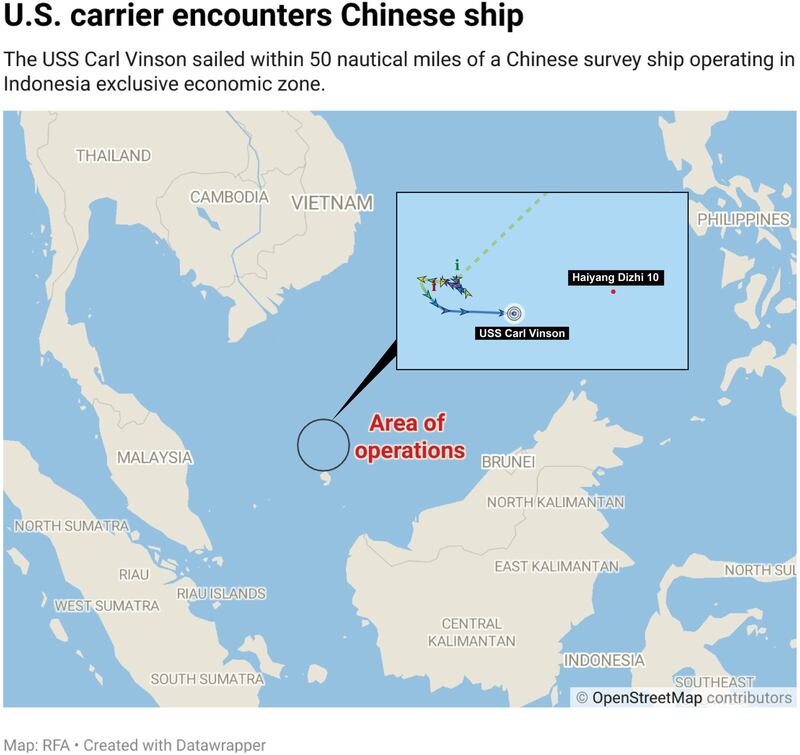The commander of a U.S. aircraft carrier deployed in the South China Sea has told RFA it aims to ensure the "freedom of all nations to navigate in international waters" -- a mission that saw it pass just 50 nautical miles from a Chinese survey ship operating in Indonesia exclusive economic zone (EEZ) this weekend.
Global marine traffic records show early on Sunday, the USS Carl Vinson (CVN-70) was sailing in the Natuna Sea off Indonesia, near where the Chinese survey vessel Haiyang Dizhi 10 has been operating since late August.
Unusually, the U.S. super carrier also broadcasted its location, a move that analysts say would be intended to show that it is operating freely in international waters. China claims most of the South China Sea for itself.
In an exclusive interview with RFA on Saturday, the commander of the Carl Vinson Strike Group, Rear Adm. Dan Martin, said: “Our operations in the region are really the expression of our willingness to defend both our interests and the freedoms enshrined in international laws.”
The carrier strike group including the aircraft carrier USS Carl Vinson (CVN-70) and three other military vessels entered the South China Sea last week to conduct “maritime security operations”.
Just a few days earlier, the Chinese Maritime Safety Administration announced that all foreign vessels, including aircraft carriers entering what China considers to be its territorial waters had to notify Beijing and submit to Chinese supervision.
Under international law, territorial waters are the 12 nautical miles of sea extending from a country’s terrestrial territory. But China also includes waters around its newly-reclaimed artificial islands in its maritime jurisdiction despite protests from other countries in the region.
“Any coastal state law or regulation must not infringe upon navigation and overflight rights enjoyed by all nations under international law,” Martin said.
“Unlawful and sweeping maritime claims including in the South China Sea pose a significant threat to the freedoms of the seas, including freedom of navigation, overflight and lawful commerce.”
"We're not going to be coerced or forced to cede the international norms," he said.
'People’s Liberation Army on alert'
U.S. naval and air forces periodically conduct so-called Freedom of Navigation Operations (FONOPs) to challenge China’s maritime claims in the South China Sea, where a third of global maritime trade transits each year. China has repeatedly denounced these FONOPs.
The Global Times, part of China's official mouthpiece People's Daily, has also called the USS Carl Vinson's deployment "provocative."
This is the sixth time a U.S. aircraft carrier has been deployed in the South China Sea this year, but the first time with the advanced capabilities of F-35C stealth fighter and the new CMV-22B Osprey tiltrotor aircraft, the Global Times noted.
The paper quoted a Chinese military expert as warning that the Chinese army has been put on alert, and “China is fully capable of and confident in dealing with such provocations.”
However, according to the commander of the Carl Vinson Strike Group, “all our interactions thus far with the Chinese navy have been professional and safe. As we sail around, we do have some escorts but I haven’t seen any aggressive maneuvering either on the sea or in the air that would give me concerns.”
An RFA review of ship-tracking data showed that as the Carl Vinson passed through the southern part of the South China Sea, it was at one point about 50 nautical miles from the Haiyang Dizhi 10 – one of China’s fleet of survey vessels that periodically conduct research in disputed waters.
The area where the Haiyang Dizhi was operating Sunday is within the 200-nautical-mile exclusive economic zone of Indonesia. Jakarta does not regard itself as a party to the territorial disputes in the South China Sea, although Beijing claims historic rights to parts of that maritime region overlapping Indonesia’s EEZ.

Indonesia's Maritime Security Agency (Bakamla) said on Tuesday that there had been no violation of shipping rules by the Haiyang Dizhi.
Bakamla spokesman Wisnu Pramandita said the Chinese survey ship was seen near the Tuna Natuna Block gas field on Aug. 31.
"I don't know how long exactly [it was there]. But it had its AIS [automatic identification system] on and could be monitored. There are no reports of disruptions from the rig. It was probably normal passage,” Wisnu told BenarNews, and RFA-affiliated online news service.
Indonesia requires foreign ships that are passing through the Indonesian Archipelagic Sea Lane (ALKI) to turn on their AIS.
Wisnu said Bakamla also monitored the presence of the USS Carl Vinson in the Indonesian EEZ, but said he was not aware of any interaction with the Chinese vessel.
Martin said that due to COVID-19 restrictions, it’s unlikely that the USS Carl Vinson would be able to make any port call on its mission, but the aircraft carrier’s open-ended deployment should “show our partners and allies that we stand with them.”
He reiterated the U.S commitment to defend South China Sea claimant the Philippines should it come under attack, describing it as “our oldest treaty ally in Asia.”
“An armed attack against the Philippine armed forces, public vessels or aircrafts in the Pacific, including in the South China Sea would trigger an obligation under the U.S.-Philippine Mutual Defense Treaty,” Martin said.
Philippine Defense Secretary Delfin Lorenzana was in Washington, D.C., last week to meet U.S. officials. According to a Philippine statement, “both sides agreed to work on a bilateral maritime framework that advances cooperation in the maritime domain.”
Speaking at the Center for Strategic and International Studies think tank last Wednesday, Lorenzana said Manila was seeking to “upgrade and update” the U.S. alliance. He pressed for a clearer “extent of American commitments” under the treaty, which was signed by the two allies 70 years ago.
Additional reporting by BenarNews, an RFA-affiliated online news service.
